Rome
![]()
The title of this article is ambiguous. For other meanings, see Rome (disambiguation).
Rome (Latin Rōma; Italian Roma [ˈroːma], officially Roma Capitale) is the capital of Italy, capital of the Lazio region, and historical capital of the Roman Empire and the Papal States. The city is located in the middle of the Italian peninsula on the Tiber River. With a population of about three million in the metropolitan area and about four million in the agglomeration, it is the largest city in Italy as well as the third largest in the European Union. In addition, Rome is also the most extensive city in the country in terms of area, with a municipal area of 1287.36 km².
Rome was first called the Eternal City in the 1st century BC by the poet Tibull. This designation, originally an antonomasia, became an honorific name for the city because of its importance in its history, which spans three millennia to the present day. According to legend practiced by the Romans, Rome was founded in 753 BC, but is probably older. After shaking off the influence of the Etruscans, Rome established itself as an independent city-state, which over the centuries came to possess Italy and subsequently most of the ancient Mediterranean. Latin, spoken local dialect and Italic language, which originated in the city of Rome, spread throughout Italy, especially in the southwestern Mediterranean, as a result of the Roman expansion, and fundamentally influenced the local languages there, leading to the emergence of the Romance languages. Classical Latin has persisted as the lingua franca of science, philosophy, art, theology, politics, and diplomacy into modern times. Ancient Roman city law has left a significant influence on European legal systems to this day.
Even before the decline of the Western Roman Empire, Rome lost population and political influence, but through the Middle Ages and modern times it was a center of the Christian religion and still forms one of the centers of the Occident. After being conquered by Italian troops, since 1871 Rome has once again been part of a united Italy as far as the Alps, as it was for centuries in antiquity: "all roads lead to Rome". The Chamber of Deputies, the Senate, the President, the Government and the Constitutional Court of the Italian Republic are based in Rome, also today the administrative seat of the Lazio Region and the Metropolitan City of Rome-Capital, which replaced the previous Province of Rome in 2015. Rome is divided into 15 municipi.
Roma capitale ("Rome capital") holds a special status as a municipality. Within the city limits is the state (the) Vatican City. It is an independent landlocked state and the seat of the Pope, i.e. the Bishop of Rome. The latter forms an independent subject of international law, which means that the city of Rome has been home to two of three non-state subjects of international law since 1834 (when the seat of the Order of Malta was established). It is also home to the UN agencies FAO, IFAD and WFP.
Rome is extraordinarily rich in important buildings and museums and a destination for many tourists. The Old Town of Rome, St. Peter's Basilica and the Vatican City were declared World Heritage Sites by UNESCO in 1980.

Satellite image of Rome
Geography

enlarge and show information about the picture
![]()
Panoramic view of Rome, the Vatican Museums, St. Peter's Square and the Vatican Audience Hall (seen from the dome of St. Peter's Basilica)
Extension of the urban area
Rome is located in the middle of Italy on the Tiber, not far from the Tyrrhenian Sea, an average of 37 meters above sea level. In several meanders the Tiber flows in a southerly direction through the city. In the north, in the district of Parioli, the Aniene flows into it. The further surroundings are the Campagna Romana or short Campagna. In the east of Rome are the Abruzzi, in the northeast the Sabine Mountains and in the southeast the Alban Hills.
The Metropolitan City of Rome is bordered to the north by the Province of Viterbo and the Province of Rieti, to the east by the Province of L'Aquila in the Abruzzo region, and to the south by the Province of Frosinone and the Province of Latina.
City breakdown
→ Main article: Urban division of Rome
Rome is divided into four boroughs, 15 municipalities and 155 urban areas.
The 15 (until 11 March 2013 there were 19) municipalities are: (1) Municipio I (with the old town Centro Storico, Prati and other ancient districts), (2) Parioli and Nomentano - San Lorenzo, (3) Monte Sacro, (4) Tiburtina, (5) Prenestino and Centocelle, (6) delle Torri, (7) San Giovanni and Cinecittà, (8) Appia Antica, (9) EUR, (10) Ostia, (11) Arvalia Portuense, (12) Monte Verde, (13) Aurelia, (14) Monte Mario and (15) Cassia Flaminia.
The old town (Municipio 1) is divided into 22 rioni (districts), some of which date back to ancient times. They no longer have any administrative significance.
The old Municipio 14 was demunicipalized in 1992 and is now the independent city of Fiumicino.
A realistic overview of the historic city is also provided by the 16 × 17 m plaster model Plastico di Roma Antica in the Museo della Civiltà Romana on a scale of 1:250.
· 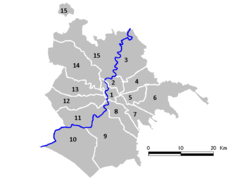
municipalities of Rome
Climate
Rome's climate is typically Mediterranean, dry in summer (arid) and humid in winter (humid). The dryness in summer is due to the displacement of the subtropical high pressure belt; in this high pressure zone the air sinks and clouds are dissolved. The subtropical high-pressure belt shifts southwards in winter and a humid extratropical westerly wind zone moves into the Mediterranean area from the north.
| Rome | ||||||||||||||||||||||||||||||||||||||||||||||||
| Climate diagram | ||||||||||||||||||||||||||||||||||||||||||||||||
| ||||||||||||||||||||||||||||||||||||||||||||||||
| Climate table Rome
Source: wetter.de; humidity, water temperature: wetterkontor.de | ||||||||||||||||||||||||||||||||||||||||||||||||||||||||||||||||||||||||||||||||||||||||||||||||||||||||||||||||||||||||||||||||||||||||||||||||||||||||||||||||||||||||||||||||||||||||||||||||||||||||||||||||||||||||||||||||||||||||||||||||||||||||||||||||||||||||||||||||||||||||||
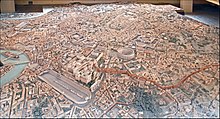
Model of ancient Rome
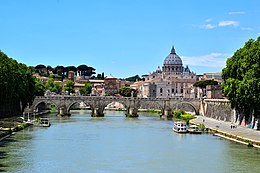
The Tiber with a view of the Bridge of Angels and St. Peter's Basilica
History
Ancient
See also: Roman Empire
Foundation
According to the founding legend, Rome was founded by Romulus on April 21, 753 BC. According to the legend, Romulus later killed his twin brother Remus when the latter was amused by the city wall built by Romulus. According to the legend, the twins were the children of the god Mars and the vestal virgin Rhea Silvia. They were abandoned on the Tiber, suckled by a she-wolf and then found and raised by the shepherd Faustulus on the Velabrum below the Palatine.
The Roman astrologer Lucius Tarrutius, a friend of the scholar Marcus Terentius Varro, deviating from the known date of foundation, calculated October 4, 754 BC between the 2nd and 3rd hour of the day as the time of foundation, assuming a birth chart of Romulus.
Excavations on the Palatine revealed settlement remains from around 1000 BC; probably some Latin and Sabine villages were then united into a city around 800 BC (perhaps by Etruscans) or grew together.
Royal period and republic
Thus, according to historians, the amalgamation of individual settlements into a commonwealth may have actually occurred around the legendary founding date. The proverbial seven hills of Rome are: Palatine, Aventine, Capitoline, Quirinal, Viminal, Esquiline and Caelius. Today, the city area also extends over the famous hills of Gianicolo, Vaticano and Pincio.
At the beginning of its history Rome was a kingdom; Titus Livius names Numa Pompilius as the first of the - largely legendary - successors of Romulus. After the expulsion of the last Etruscan king Tarquinius Superbus - allegedly in 509 BC - Rome became a republic - although this probably did not actually happen until around 475 BC. The period that followed was marked by class struggles between the lawless, if free, plebeians and the noble patricians. Rome now began to annex the surrounding territories.
Although Rome could hardly resist an invasion by the Celts in 390 BC, the city nevertheless expanded steadily. To protect it from further invasions, the Servian Wall was built (see in the figure The Seven Hills of Rome). 312 B.C. followed the construction of the first aqueduct as well as the construction of the Via Appia. The Punic Wars (264-146 BC) against the North African Carthage, which controlled the western Mediterranean, also contributed to Rome's expansion.
After the brothers Tiberius and Gaius Sempronius Gracchus, who as tribunes of the people had tried to implement land reforms, were assassinated, there was a period of instability that culminated in civil wars. Gaius Iulius Caesar, as dictator, pushed through a series of reforms but was assassinated in 44 BC. By this time, the Roman Forum had reached a building density that made it necessary to expand the area. For this reason, Caesar had begun with the construction of the Forum Iulium.
Imperial Era
In the 1st century AD, Rome was probably already a city of millions and both the geographical and political centre of the Roman Empire. It had a functioning fresh water and sewage system, a developed road network and functioning population protection units (vigiles), which served as fire brigades with police powers. The expansion of Rome, which had been especially pushed under Caesar's heir Augustus, the first emperor, was temporarily set back by a great fire of Rome under Nero in 64.
Under the rule of the Flavian dynasty (69-96 AD), extensive building activities began, financed by the emperors. These new public buildings include some of the most famous monuments such as the Colosseum and part of the imperial fora. The last of these forums was completed in the early 2nd century under Emperor Trajan. This period is often considered the peak of the Roman Empire. Large thermal complexes, such as those built by Caracalla and Diocletian in the 3rd century, which even included libraries, had become an integral part of urban Roman life. Obsessed with the idea of surpassing their predecessors, the emperors built ever larger structures, such as the basilica of Maxentius. This is sometimes seen as an indication that the empire was beginning to decline, but more importantly it shows that Rome was still the main stage for rulerly self-expression until the early 4th century. Furthermore, the Aurelian Wall was built in the late 3rd century, as the city had long since outgrown the confines of the Servian Wall.
· 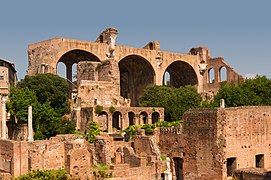
Maxentius Basilica in the Roman Forum
· 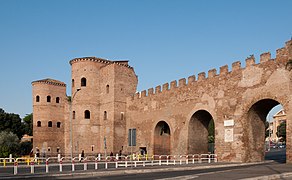
Aurelian Wall
Late Antiquity
See also: Decline of the Roman Empire
At the beginning of Late Antiquity, around the year 300, Rome probably reached its largest population; the most common assumptions are around an estimated 1.2 million inhabitants. The city soon lost political importance, however, as the various emperors preferred other residences (including Ravenna, Constantinople, Milan, Trier, Thessalonica, Split). Constantinople in particular rose to rival status in the 4th century.
In the 5th century, the western half of the empire fell into a vicious circle of civil wars and external attacks, which also affected the city of Rome. The sacking of Rome in 410 by mutinous Gothic mercenaries and again in 455 by the Vandals was a signal. The civil war between Anthemius and Ricimer was fought in 472, mainly in Rome, and also greatly affected the city. More importantly, in 429 the city lost control over North Africa, on whose grain supplies it depended. From then on the number of inhabitants decreased rapidly, although emperors like Valentinian III or Anthemius resided at the Tiber again for longer periods of time.
After the end of the Western Roman Empire in 476, however, large urban institutions such as the Baths of Diocletian and the Colosseum were initially maintained; despite declining population numbers, ancient life continued. The senate also continued to exist. Procopius recorded that the city's buildings were maintained during the rule of the Ostrogoths. Theoderic the Great had animal races and chariot races held. By 530, about 100,000 people still lived in Rome. The civilizational catastrophe came with the Gothic Wars and the reconquest policy of the Eastern Roman Emperor Justinian. The long warfare led to the final destruction of almost all Roman aqueducts (537), to the widespread extinction of the senatorial class preserving the ancient heritage, and to a suspension of urban life for several years due to Eastern Roman-Gothic siege battles. As a result, the population sank to a few tens of thousands. In 550 the last chariot races took place in the Circus Maximus.
Although Italy had formally belonged to the Eastern Roman Empire again since 554, the functions of order in Rome were increasingly exercised by the popes during the times of the "migration of peoples". The Eastern Roman-Byzantine exarch did not reside on the Tiber, but in Ravenna; Rome sank to the status of a Byzantine provincial city and now also lost its symbolic significance; only the papacy still provided a remnant of splendour and relevance. The last late antique building in the heavily depopulated city was the Phocas Column, erected in 608. Soon thereafter, the Roman Forum seems to have lost its significance for the city for good; the ancient monuments fell into disrepair.
Medieval
Since Pippin, Rome gained new importance as the capital of the Papal States (Patrimonium Petri) and as the most important place of pilgrimage of Christianity next to Jerusalem and Santiago de Compostela. New splendour came to the city in 800, when Charlemagne was crowned Emperor of the Holy Roman Empire by Pope Leo III. Between 843 and 849, three attempts at conquest by Muslim Arabs failed, but the half of the city on the right bank of the Tiber was sacked in 846.
Between the 8th and 11th centuries, further sieges, attacks and plundering by Lombards, Saracens and Normans followed. Around 800, the population was just 20,000. As a result of the rapid decline in population, a good three quarters of the city area enclosed by the Aurelian Wall became deserted, and in the following period lay fallow and became overgrown or was later used for agricultural purposes. The densely populated parts of the city were concentrated on the surrounding banks of the Tiber, on the Field of Mars and on the Borgo between St. Peter's Basilica and Castel Sant'Angelo. In the area within the Aurelian Wall, this established the particular contrast between the abitato (densely populated Tiber banks, Field of Mars, Borgo) and disabitato (fallow, uninhabited landscape areas) areas that would characterize Rome from the 11th to the 19th century. The ancient city centers, the Roman Forum, the Capitol, the Imperial Forums, the Colosseum, etc., were all located in the uninhabited disabitato. The new centres of Rome were now the Borgo with Old St. Peter's and the Campo de' Fiori. In the disabitato existed in the Middle Ages at times own small settlements, which had formed around the large churches of Rome outside the abitato, such as around the Lateran Basilica or around the church of Santa Maria Maggiore.
The tomb of the Apostle Paul, who was executed after the burning of Rome under Nero in 64, was assumed by the Catholic Church to be directly in Rome, and numerous other relics promised pilgrims extraordinary graces and indulgences during the Holy Years from 1300 onwards. The assumption that Simon Peter was executed together with Paul and buried in Rome contributed to this. This assumption is still highly controversial among historians today. The pilgrims represented a mainstay of the commune, which had been striving for self-government since the 12th century. A first revival of the commune in dispute with the papacy, with the participation of the church reformer Arnold of Brescia, was violently interrupted with the coronation of Frederick Barbarossa as emperor in 1155.
Renaissance
Rome's Renaissance flourishing was interrupted in 1527 by the Sacco di Roma 'Sack of Rome', when Charles V's mercenary troops sacked and ravaged Rome.
Many important buildings were built in Christian times, for example the so-called four patriarchal basilicas of Saint Paul Outside the Walls over the tomb of Saint Paul the Apostle from the 4th century, the Lateran Basilica, also from the 4th century, baroqueised by Francesco Borromini, Santa Maria Maggiore from the 5th century and above all Saint Peter's Basilica, which in its present form dates from the Renaissance and Baroque periods.
During the Renaissance and Baroque periods, the city found a new character, determined mainly by churches, but also by new streets with sight lines on palaces and squares with fountains and obelisks. Rome has remained in this state until today, which is why the old town of Rome is one of the two World Heritage Sites in the city of Rome, along with the Vatican.
· 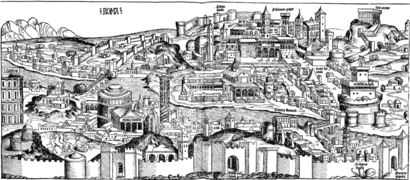
Rome around 1490
· 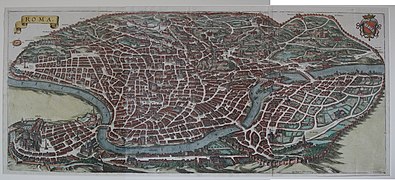
View of Rome, ca. 1640
capital of Italy
In 1849 France stationed troops in the Papal States. In the summer of 1870, when the First Vatican Council was in recess, France withdrew them from Rome after declaring war on Prussia. On September 20, 1870, Bersaglieri broke through the Porta Pia and marched into Rome, completing the unification of Italy. The Papal States were annexed to Italy by decree on 6 October 1870.
By a law signed by King Victor Emmanuel II on 3 February 1871, Rome was declared the capital of the Italian nation-state created as a kingdom during the Risorgimento; previously Turin and, from 1865, Florence had held this role. In the summer of 1871 the government moved from Florence to Rome. The Pope, deprived of his temporal power, as well as large sections of the Catholic population, were hostile to this new state for decades. Toward the end of the 19th century, a large influx began from the rural areas of Italy, causing Rome to grow beyond the city limits of the Aurelian Wall for the first time since antiquity. In 1922, the fascists under Benito Mussolini took power in Italy with the March on Rome. Under the fascist dictatorship, the differences between the state and the church were ended by the Lateran Treaties with the Holy See in 1929, establishing the independent state of Vatican City. Moreover, during this period, as part of the propagandistic glorification of Roman antiquity, antiquities were restored, the monumental national memorial Monumento Vittorio Emanuele II was completed in 1927, new buildings and sight lines were created in the historic center, and the EUR (Esposizione Universale di Roma) district was built. The most famous of the EUR's often futuristic-looking new buildings is the Palazzo della Civiltà Italiana (also Palazzo del Lavoro). Unlike in Germany, for example, fascist inscriptions and symbols were almost never removed, so that the architectural and propagandistic representation of fascism are still visible in the cityscape.
· 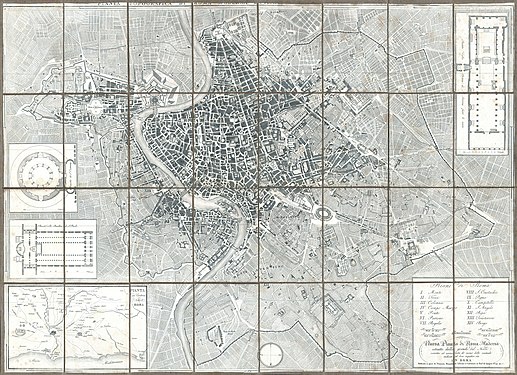
Map of Rome c. 1843, showing the contrast between the abitato and disabitato areas within the Aurelian Wall.
Second World War
On July 19, 1943, the Allies bombed Rome for the first time. A main target of the 390 bombers of the United States Air Force was the Tiburtina railway station. However, it was mainly the working-class districts of San Lorenzo and the church of San Lorenzo fuori le mura that were destroyed. Immediately after the Armistice of Italy on 8 September 1943, the German occupation of Rome began, according to the directives laid down in Fall Achse, with several repressive measures against the civilian population, including the raid against the Jewish population of Rome on 16 October 1943, during which over 1000 inhabitants of the Jewish ghetto were deported to Auschwitz. One day after the assassination carried out by communist partisans in Via Rasella, Herbert Kappler ordered the massacre in the Ardeatine Caves on 24 March 1944, in which 335 Italian civilians were killed. Even during the air raids that followed and when Allied troops approached the city in May 1944, Pope Pius XII persevered in Rome. To prevent a second Monte Cassino or even Stalingrad, he sought an all-round declaration of Rome as an "open city." On the German side, the plan received support from Ernst von Weizsäcker and SS General Karl Wolff, among others. German Field Marshal Albert Kesselring declared Rome an open city in early June 1944 and withdrew all but a rearguard of troops. On June 4, 1944, Allied troops marched into Rome.
After the Second World War, King Umberto II left the country in 1946 and Italy became a republic.
Rome as a modern metropolis
In the post-war decades, Italy experienced an unprecedented economic boom (miracolo economico) and a strong rural exodus: Millions of people from southern Italy and the mountainous regions of Abruzzo flocked to the capital. In order to eliminate the shantytowns of the immediate post-war period, large housing estates sprang up from 1962 onwards, as in all major Italian cities. In Rome, these were often placed unplanned and without planning permission in the Roman Campagna and subsequently legalised for a fee. At the same time, the 1960s and 1970s also saw the emergence of residential areas for the aspiring middle class. By 1980, the city's population had doubled.
In 1955 the first line of the metro Metropolitana di Roma was opened and in 1960 Rome hosted the XVII Summer Olympic Games.
The so-called borgate abusive 'abusive suburbs' often offered no infrastructure at all, no green spaces, no schools or kindergartens. While in the inner city the churches are often hardly to be preserved due to their overcrowding, they were initially completely absent in the surrounding areas. While in the meantime numerous new churches have been built in the suburbs, there are still no green spaces or sports facilities and the connection to public transport is insufficient. The social problems of the suburbs were the cause of social struggles of the radical left, squats and strikes in the 1970s. Left-wing and right-wing extremist groups (opposti estremisti) engaged in violent confrontations with the police; at the same time, organized crime also proliferated in these years, the involvement of which is exemplified by the case of the Magliana gang. The sad climax of the political violence of the 1970s throughout the country was the kidnapping and murder of Prime Minister Aldo Moro by members of the Red Brigades in 1978. The latest example in time of this urban planning, often considered a failure, is the Corviale housing complex (also called il serpentone 'the giant snake'), built in 1975-1982. In the 1980s the situation eased somewhat and part of Rome's middle class left the city in the course of suburbanisation.
Under the pontificate of Pope John Paul II, the city twice experienced unprecedented crowds. In the Holy Year 2000, two million people came to the gates of the city for the World Youth Day service. The funeral ceremonies in St. Peter's Square on April 8, 2005, were attended by 200 heads of state and government and three to four million people from around the world, but only 300,000 of them could be seated; the rest watched the ceremonies on large video screens.
Since the election of Mayor Francesco Rutelli in 1993, improvements in air quality have been achieved, but little has changed in the city's structural problems such as traffic or waste disposal under him and his successors. After years of being governed by centre-left mayors, the election of national conservative Gianni Alemanno in 2008 marked a break; during his tenure, the city's problems continued to worsen and, under his Socialist successor Ignazio Marino, a gigantic corruption scandal involving the Mafia Capitale criminal network was uncovered in 2015. In the summer of 2016, Romans' disenchantment with the established parties brought Virginia Raggi of the protest movement MoVimento 5 Stelle to the city's leadership.
Rome today
The large buildings of the 20th century were almost all erected in the outer districts such as the EUR; in the city centre, on the other hand, building work is rarely permitted for reasons of monument preservation. Large excavations are currently taking place in the area of the ancient imperial fora. In the modern cityscape, the past can still be found in many places. For example, the theatre of Pompeius at Campo de' Fiori from the 1st century BC, in whose forecourt the Curia was housed in Caesar's time and where he was probably also killed, is still largely preserved. However, over the centuries, the semicircle for the spectators has become a residential building. Today it houses cellars and an underground car park, restaurants and bars, private apartments and hotel pensions. All rooms have a trapezoidal floor plan due to the original semicircular theatre structure.
The renewal of the city often poses great problems for the Romans in everyday life. Already the construction of a huge underground car park to the year 2000 into a tuff hill at St. Peter's Square was controversial, because the destruction of archaeological remains was feared. For the same reason, the urgently needed third metro line was only opened in 2014/2015.
The often unattractive suburbs with their high crime rate pose greater problems than the historic inner city. There are still no green spaces or sports facilities, and public transport connections are inadequate. To this day, there are hardly any public baths in the former city of "spas for all". Those Romans who can afford it own an apartment in one of the often leafy and carefully tended courtyards or even a small villa in the city area.
In a 2018 ranking of cities by quality of life, Rome ranked 57th among 231 cities surveyed worldwide.
See also: Chronological table Rome
Population development
Rome's history began around 800 BC with a confederation of various small villages with a few hundred to a thousand inhabitants. From then on, Rome grew steadily over the next centuries into a mega-city with a population of over one million. In the course of the transfer of important capital functions to Constantinople in the 4th century, as well as the disintegration of the Western Roman Empire in the 5th century, the population decreased significantly and quickly fell to about 100,000 by 530.
In the early Middle Ages, Rome was a small town with 20,000 inhabitants compared to today. It was only with the rise of the Papal States that Rome flourished again, although wars and epidemics repeatedly interrupted this development. When it became the capital of united Italy in 1871, it had a good 210,000 inhabitants, thirty years later it was already twice as many. In the 20th century, Rome grew again to a city of millions, whereby specially after 1945, the number of inhabitants increased drastically. The following overview shows the population figures according to the respective territorial status. Up to 1858, these are estimates; from 1871 to 2015, they are census results and updates from the National Institute of Statistics (ISTAT).
|
|
|
(*) Occidental schism 1309-1376, plague epidemic 1348/50
(**) Sacco di Roma 1527 (plundering by German lansquenets and Spanish and Italian mercenaries)

Piazza Venezia with the Monumento Vittorio Emanuele II
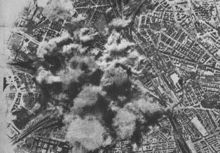
Allied air raids on Rome on 19 July 1943
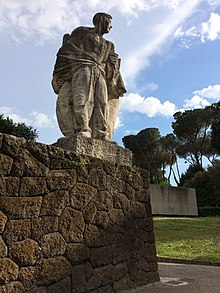
Entrance to the memorial Fosse Ardeatine
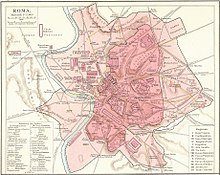
ancient Rome

The naval battle of Ostia in 849 stopped the third Arab attack

In September 1870, the Bersaglieri conquered Rome and completed the unification of Italy.

The fire of Rome July 18, 64 A. D., Hubert Robert
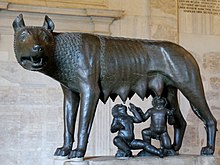
The Capitoline she-wolf suckles the boys Romulus and Remus, bronze, Capitoline Museums

Colosseum; built 80 AD.
.jpg)
The Spanish Steps, in Italian Scalinata di Trinità dei Monti, with the church Santissima Trinità dei Monti in the background.
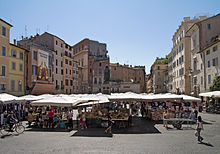
Market on the Campo de' Fiori
.jpg)
Opening ceremony of the 1960 Summer Olympics
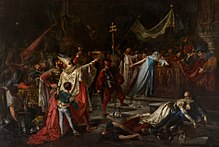
Sacco di Roma , Francisco J. Amérigo, 1884

Via Appia Antica
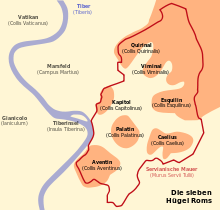
Schematic map of the seven hills of Rome
Questions and Answers
Q: What is Rome?
A: Rome is the capital city of Italy.
Q: Where is Rome situated?
A: Rome is situated on the Tiber River in the region of Lazio, Italy.
Q: How many people live in Rome?
A: Rome has a population of 2.8 million people, but an estimate by the OECD put the number of people in the greater area of Rome at 3.47 million.
Q: Why was Rome called the Eternal City?
A: Rome was called the Eternal City because when the Roman Empire was new, it was already very old.
Q: What is the Vatican City?
A: The Vatican City is an enclave located in the north-west part of Rome, and is the home of the Catholic Church and its leader, the Pope.
Q: What is the largest city in Latium?
A: Rome is the largest city in Latium.
Q: What region is Rome located in?
A: Rome is located in the geographical region of Latium.
Search within the encyclopedia